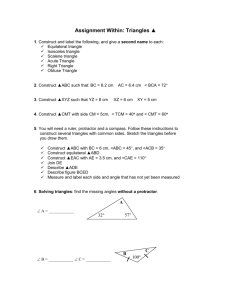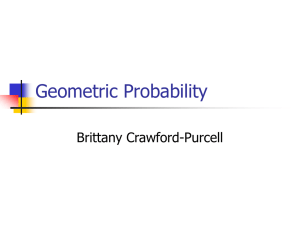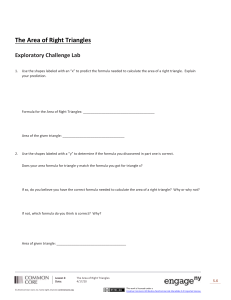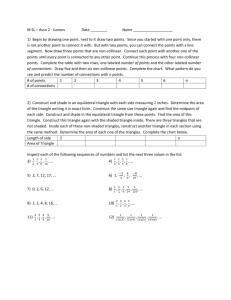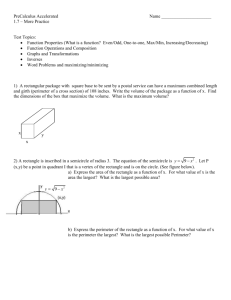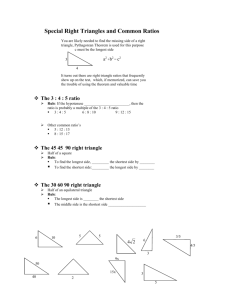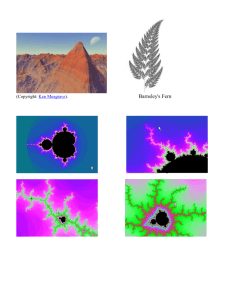Lesson 1: Construct an Equilateral Triangle
advertisement
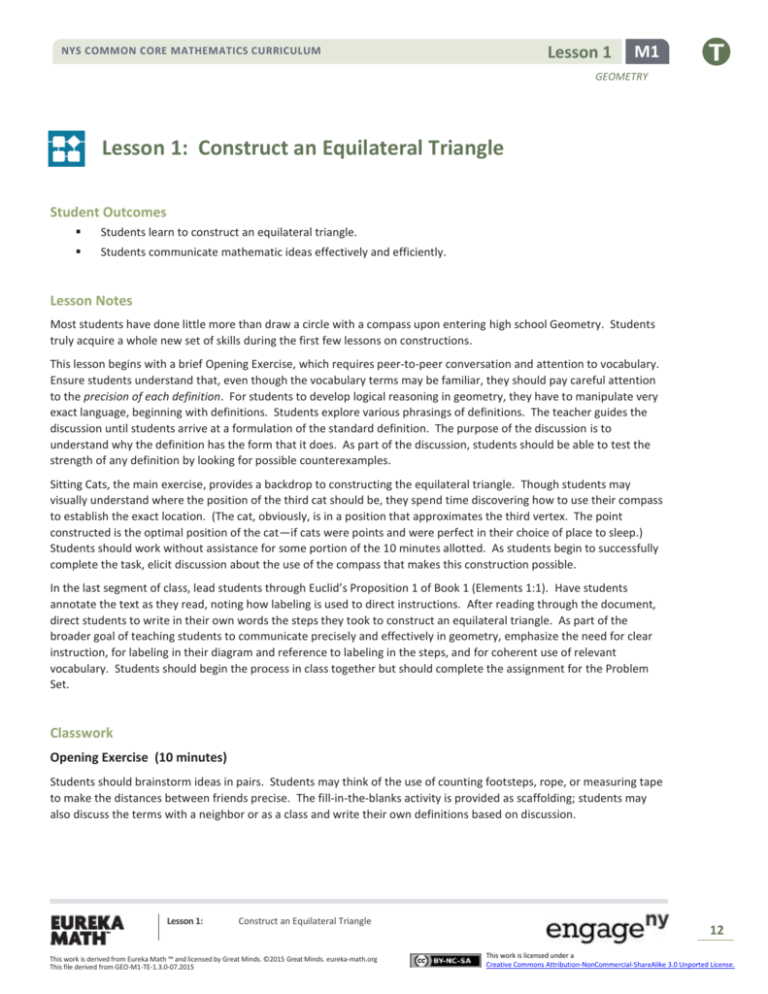
Lesson 1 NYS COMMON CORE MATHEMATICS CURRICULUM M1 GEOMETRY Lesson 1: Construct an Equilateral Triangle Student Outcomes Students learn to construct an equilateral triangle. Students communicate mathematic ideas effectively and efficiently. Lesson Notes Most students have done little more than draw a circle with a compass upon entering high school Geometry. Students truly acquire a whole new set of skills during the first few lessons on constructions. This lesson begins with a brief Opening Exercise, which requires peer-to-peer conversation and attention to vocabulary. Ensure students understand that, even though the vocabulary terms may be familiar, they should pay careful attention to the precision of each definition. For students to develop logical reasoning in geometry, they have to manipulate very exact language, beginning with definitions. Students explore various phrasings of definitions. The teacher guides the discussion until students arrive at a formulation of the standard definition. The purpose of the discussion is to understand why the definition has the form that it does. As part of the discussion, students should be able to test the strength of any definition by looking for possible counterexamples. Sitting Cats, the main exercise, provides a backdrop to constructing the equilateral triangle. Though students may visually understand where the position of the third cat should be, they spend time discovering how to use their compass to establish the exact location. (The cat, obviously, is in a position that approximates the third vertex. The point constructed is the optimal position of the cat—if cats were points and were perfect in their choice of place to sleep.) Students should work without assistance for some portion of the 10 minutes allotted. As students begin to successfully complete the task, elicit discussion about the use of the compass that makes this construction possible. In the last segment of class, lead students through Euclid’s Proposition 1 of Book 1 (Elements 1:1). Have students annotate the text as they read, noting how labeling is used to direct instructions. After reading through the document, direct students to write in their own words the steps they took to construct an equilateral triangle. As part of the broader goal of teaching students to communicate precisely and effectively in geometry, emphasize the need for clear instruction, for labeling in their diagram and reference to labeling in the steps, and for coherent use of relevant vocabulary. Students should begin the process in class together but should complete the assignment for the Problem Set. Classwork Opening Exercise (10 minutes) Students should brainstorm ideas in pairs. Students may think of the use of counting footsteps, rope, or measuring tape to make the distances between friends precise. The fill-in-the-blanks activity is provided as scaffolding; students may also discuss the terms with a neighbor or as a class and write their own definitions based on discussion. Lesson 1: Construct an Equilateral Triangle This work is derived from Eureka Math ™ and licensed by Great Minds. ©2015 Great Minds. eureka-math.org This file derived from GEO-M1-TE-1.3.0-07.2015 12 This work is licensed under a Creative Commons Attribution-NonCommercial-ShareAlike 3.0 Unported License. NYS COMMON CORE MATHEMATICS CURRICULUM Lesson 1 M1 GEOMETRY Opening Exercise Joe and Marty are in the park playing catch. Tony joins them, and the boys want to stand so that the distance between any two of them is the same. Where do they stand? How do they figure this out precisely? What tool or tools could they use? Fill in the blanks below as each term is discussed: a. Segment The _______ between points 𝑨 and 𝑩 is the set consisting of 𝑨, 𝑩, and all points on the line 𝑨𝑩 between 𝑨 and 𝑩. b. Radius A segment from the center of a circle to a point on the circle c. Circle Given a point 𝑪 in the plane and a number 𝒓 > 𝟎, the _______ with center 𝑪 and radius 𝒓 is the set of all points in the plane that are distance 𝒓 from point 𝑪. Note that because a circle is defined in terms of a distance, 𝒓, we often use a distance when naming the radius (e.g., ̅̅̅̅.” “radius 𝑨𝑩”). However, we may also refer to the specific segment, as in “radius 𝑨𝑩 Example 1 (10 minutes): Sitting Cats Students explore how to construct an equilateral triangle using a compass. Example 1: Sitting Cats You need a compass and a straightedge. Margie has three cats. She has heard that cats in a room position themselves at equal distances from one another and wants to test that theory. Margie notices that Simon, her tabby cat, is in the center of her bed (at S), while JoJo, her Siamese, is lying on her desk chair (at J). If the theory is true, where will she find Mack, her calico cat? Use the scale drawing of Margie’s room shown below, together with (only) a compass and straightedge. Place an M where Mack will be if the theory is true. MP.5 Lesson 1: Construct an Equilateral Triangle This work is derived from Eureka Math ™ and licensed by Great Minds. ©2015 Great Minds. eureka-math.org This file derived from GEO-M1-TE-1.3.0-07.2015 13 This work is licensed under a Creative Commons Attribution-NonCommercial-ShareAlike 3.0 Unported License. Lesson 1 NYS COMMON CORE MATHEMATICS CURRICULUM M1 GEOMETRY Mathematical Modeling Exercise (12 minutes): Euclid, Proposition 1 Students examine Euclid’s solution of how to construct an equilateral triangle. Lead students through this excerpt, and have them annotate the text as they read it. The goal is for students to form a rough set of steps that outlines the construction of the equilateral triangle. Once a first attempt of the steps is made, review them as if they are a step-by-step guide. Ask the class if the steps need refinement. This is to build to the Problem Set question, which asks students to write a clear and succinct set of instructions for the construction of the equilateral triangle. Mathematical Modeling Exercise: Euclid, Proposition 1 Let’s see how Euclid approached this problem. Look at his first proposition, and compare his steps with yours. In this margin, compare your steps with Euclid’s. Geometry Assumptions (7 minutes) Geometry Assumptions In geometry, as in most fields, there are specific facts and definitions that we assume to be true. In any logical system, it helps to identify these assumptions as early as possible since the correctness of any proof hinges upon the truth of our assumptions. For example, in Proposition 1, when Euclid says, “Let 𝑨𝑩 be the given finite straight line,” he assumed that, given any two distinct points, there is exactly one line that contains them. Of course, that assumes we have two points! It is best if we assume there are points in the plane as well: Every plane contains at least three noncollinear points. Lesson 1: Construct an Equilateral Triangle This work is derived from Eureka Math ™ and licensed by Great Minds. ©2015 Great Minds. eureka-math.org This file derived from GEO-M1-TE-1.3.0-07.2015 14 This work is licensed under a Creative Commons Attribution-NonCommercial-ShareAlike 3.0 Unported License. Lesson 1 NYS COMMON CORE MATHEMATICS CURRICULUM M1 GEOMETRY Euclid continued on to show that the measures of each of the three sides of his triangle are equal. It makes sense to discuss the measure of a segment in terms of distance. To every pair of points 𝑨 and 𝑩, there corresponds a real number 𝐝𝐢𝐬𝐭(𝑨, 𝑩) ≥ 𝟎, called the distance from 𝑨 to 𝑩. Since the distance from 𝑨 to 𝑩 is equal to the distance from 𝑩 to 𝑨, we can interchange 𝑨 and 𝑩: 𝐝𝐢𝐬𝐭(𝑨, 𝑩) = 𝐝𝐢𝐬𝐭(𝑩, 𝑨). Also, 𝑨 and 𝑩 coincide if and only if 𝐝𝐢𝐬𝐭(𝑨, 𝑩) = 𝟎. Using distance, we can also assume that every line has a coordinate system, which just means that we can think of any line in the plane as a number line. Here’s how: Given a line, 𝒍, pick a point 𝑨 on 𝒍 to be “𝟎,” and find the two points 𝑩 and 𝑪 such that 𝐝𝐢𝐬𝐭(𝑨, 𝑩) = 𝐝𝐢𝐬𝐭(𝑨, 𝑪) = 𝟏. Label one of these points to be 𝟏 (say point 𝑩), which means the other point 𝑪 corresponds to −𝟏. Every other point on the line then corresponds to a real number determined by the (positive or negative) distance between 𝟎 and the point. In particular, if after placing a coordinate system on a line, if a point 𝑹 corresponds to the number 𝒓, and a point 𝑺 corresponds to the number 𝒔, then the distance from 𝑹 to 𝑺 is 𝐝𝐢𝐬𝐭(𝑹, 𝑺) = |𝒓 − 𝒔|. History of Geometry: Examine the site http://geomhistory.com/home.html to see how geometry developed over time. Relevant Vocabulary (3 minutes) The terms point, line, plane, distance along a line, betweenness, space, and distance around a circular arc are all left as undefined terms; that is, they are only given intuitive descriptions. For example, a point can be described as a location in the plane, and a straight line can be said to extend in two opposite directions forever. It should be emphasized that, while we give these terms pictorial representations (like drawing a dot on the board to represent a point), they are concepts, and they only exist in the sense that other geometric ideas depend on them. Spend time discussing these terms with students. Relevant Vocabulary GEOMETRIC CONSTRUCTION: A geometric construction is a set of instructions for drawing points, lines, circles, and figures in the plane. The two most basic types of instructions are the following: 1. Given any two points 𝑨 and 𝑩, a straightedge can be used to draw the line 𝑨𝑩 or segment 𝑨𝑩. 2. Given any two points 𝑪 and 𝑩, use a compass to draw the circle that has its center at 𝑪 that passes through 𝑩. (Abbreviation: Draw circle 𝑪: center 𝑪, radius 𝑪𝑩.) Constructions also include steps in which the points where lines or circles intersect are selected and labeled. (Abbreviation: Mark the point of intersection of the line 𝑨𝑩 and line 𝑷𝑸 by 𝑿, etc.) FIGURE: A (two-dimensional) figure is a set of points in a plane. Usually the term figure refers to certain common shapes such as triangle, square, rectangle, etc. However, the definition is broad enough to include any set of points, so a triangle with a line segment sticking out of it is also a figure. EQUILATERAL TRIANGLE: An equilateral triangle is a triangle with all sides of equal length. COLLINEAR: Three or more points are collinear if there is a line containing all of the points; otherwise, the points are noncollinear. ̅̅̅̅ is the distance from 𝑨 to 𝑩 and is denoted 𝑨𝑩. Thus, 𝑨𝑩 = 𝐝𝐢𝐬𝐭(𝑨, 𝑩). LENGTH OF A SEGMENT: The length of 𝑨𝑩 Lesson 1: Construct an Equilateral Triangle This work is derived from Eureka Math ™ and licensed by Great Minds. ©2015 Great Minds. eureka-math.org This file derived from GEO-M1-TE-1.3.0-07.2015 15 This work is licensed under a Creative Commons Attribution-NonCommercial-ShareAlike 3.0 Unported License. Lesson 1 NYS COMMON CORE MATHEMATICS CURRICULUM M1 GEOMETRY In this course, you have to write about distances between points and lengths of segments in many, if not most, Problem Sets. Instead of writing 𝐝𝐢𝐬𝐭(𝑨, 𝑩) all of the time, which is a rather long and awkward notation, we instead use the much simpler notation 𝑨𝑩 for both distance and length of segments. Even though the notation always makes the meaning of each statement clear, it is worthwhile to consider the context of the statement to ensure correct usage. Here are some examples: ⃡ intersects… 𝑨𝑩 ⃡ refers to a line. 𝑨𝑩 𝑨𝑩 + 𝑩𝑪 = 𝑨𝑪 Only numbers can be added, and 𝑨𝑩 is a length or distance. ̅̅̅̅. ̅̅̅̅ so that 𝑨𝑩 ̅̅̅̅ ∥ 𝑪𝑫 Find 𝑨𝑩 ̅̅̅̅ is a segment. Only figures can be parallel, and 𝑨𝑩 𝑨𝑩 = 𝟔 ̅̅̅̅ or the distance from 𝑨 to 𝑩. 𝑨𝑩 refers to the length of 𝑨𝑩 Here are the standard notations for segments, lines, rays, distances, and lengths: A ray with vertex 𝑨 that contains the point 𝑩: 𝑨𝑩 or “ray 𝑨𝑩” A line that contains points 𝑨 and 𝑩: ⃡𝑨𝑩 or “line 𝑨𝑩” A segment with endpoints 𝑨 and 𝑩: 𝑨𝑩 or “segment 𝑨𝑩” The length of 𝑨𝑩: 𝑨𝑩 The distance from 𝑨 to 𝑩: 𝐝𝐢𝐬𝐭(𝑨, 𝑩) or 𝑨𝑩 COORDINATE SYSTEM ON A LINE: Given a line 𝒍, a coordinate system on 𝒍 is a correspondence between the points on the line and the real numbers such that: (i) to every point on 𝒍, there corresponds exactly one real number; (ii) to every real number, there corresponds exactly one point of 𝒍; (iii) the distance between two distinct points on 𝒍 is equal to the absolute value of the difference of the corresponding numbers. Closing (1 minute) How does a compass aid in the construction of a circle? Using a compass allows us to draw circles, which we need to determine the last vertex of the equilateral triangle. The first two vertices are determined by the endpoints of the segment selected to be one side of the triangle. The third vertex is determined by drawing circles with radii equal to the length of that segment around each endpoint; either of the two intersections formed by the circles can serve as the third vertex. Exit Ticket (3 minutes) Lesson 1: Construct an Equilateral Triangle This work is derived from Eureka Math ™ and licensed by Great Minds. ©2015 Great Minds. eureka-math.org This file derived from GEO-M1-TE-1.3.0-07.2015 16 This work is licensed under a Creative Commons Attribution-NonCommercial-ShareAlike 3.0 Unported License. NYS COMMON CORE MATHEMATICS CURRICULUM Lesson 1 M1 GEOMETRY Name ___________________________________________________ Date____________________ Lesson 1: Construct an Equilateral Triangle Exit Ticket We saw two different scenarios where we used the construction of an equilateral triangle to help determine a needed location (i.e., the friends playing catch in the park and the sitting cats). Can you think of another scenario where the construction of an equilateral triangle might be useful? Articulate how you would find the needed location using an equilateral triangle. Lesson 1: Construct an Equilateral Triangle This work is derived from Eureka Math ™ and licensed by Great Minds. ©2015 Great Minds. eureka-math.org This file derived from GEO-M1-TE-1.3.0-07.2015 17 This work is licensed under a Creative Commons Attribution-NonCommercial-ShareAlike 3.0 Unported License. Lesson 1 NYS COMMON CORE MATHEMATICS CURRICULUM M1 GEOMETRY Exit Ticket Sample Solution We saw two different scenarios where we used the construction of an equilateral triangle to help determine a needed location (i.e., the friends playing catch in the park and the sitting cats). Can you think of another scenario where the construction of an equilateral triangle might be useful? Articulate how you would find the needed location using an equilateral triangle. Students might describe a need to determine the locations of fire hydrants, friends meeting at a restaurant, or parking lots for a stadium, etc. Problem Set Sample Solutions 1. MP.5 2. Write a clear set of steps for the construction of an equilateral triangle. Use Euclid’s Proposition 1 as a guide. 1. Draw circle 𝑱: center 𝑱, radius 𝑱𝑺. 2. Draw circle 𝑺: center 𝑺, radius 𝑺𝑱. 3. Label one intersection as 𝑴. 4. Join 𝑺, 𝑱, 𝑴. Suppose two circles are constructed using the following instructions: ̅̅̅̅. Draw circle: center 𝑨, radius 𝑨𝑩 ̅̅̅̅. Draw circle: center 𝑪, radius 𝑪𝑫 Under what conditions (in terms of distances 𝑨𝑩, 𝑪𝑫, 𝑨𝑪) do the circles have a. One point in common? If 𝑨𝑩 + 𝑪𝑫 = 𝑨𝑪 or 𝑨𝑪 + 𝑨𝑩 = 𝑪𝑫 or 𝑨𝑪 + 𝑪𝑫 = 𝑨𝑩. b. No points in common? If 𝑨𝑩 + 𝑪𝑫 < 𝑨𝑪 or 𝑨𝑩 + 𝑨𝑪 < 𝑪𝑫 or 𝑪𝑫 + 𝑨𝑪 < 𝑨𝑩. c. Ex. Two points in common? If 𝑨𝑪 < 𝑨𝑩 + 𝑪𝑫 and 𝑪𝑫 < 𝑨𝑩 + 𝑨𝑪 and 𝑨𝑩 < 𝑪𝑫 + 𝑨𝑪. d. Ex. Ex. More than two points in common? Why? If 𝑨 = 𝑪 (same points) and 𝑨𝑩 = 𝑪𝑫. All the points of the circle coincide since the circles themselves coincide. Lesson 1: Construct an Equilateral Triangle This work is derived from Eureka Math ™ and licensed by Great Minds. ©2015 Great Minds. eureka-math.org This file derived from GEO-M1-TE-1.3.0-07.2015 Ex. 18 This work is licensed under a Creative Commons Attribution-NonCommercial-ShareAlike 3.0 Unported License. Lesson 1 NYS COMMON CORE MATHEMATICS CURRICULUM M1 GEOMETRY 3. You need a compass and a straightedge. Cedar City boasts two city parks and is in the process of designing a third. The planning committee would like all three parks to be equidistant from one another to better serve the community. A sketch of the city appears below, with the centers of the existing parks labeled as 𝑷𝟏 and 𝑷𝟐 . Identify two possible locations for the third park, and label them as 𝑷𝟑𝒂 and 𝑷𝟑𝒃 on the map. Clearly and precisely list the mathematical steps used to determine each of the two potential locations. ̅̅̅̅̅̅̅ 1. Draw a circle 𝑷𝟏 : center 𝑷𝟏 , radius 𝑷 𝟏 𝑷𝟐 . 2. Draw a circle 𝑷𝟐 : center 𝑷𝟐 radius ̅̅̅̅̅̅̅ 𝑷𝟐 𝑷𝟏 . 3. Label the two intersections of the circles as 𝑷𝟑𝒂 and 𝑷𝟑𝒃 . 4. Join 𝑷𝟏 , 𝑷𝟐 , 𝑷𝟑𝒂 and 𝑷𝟏 , 𝑷𝟐 , 𝑷𝟑𝒃 . 𝑷𝟑𝒂 𝑷𝟑𝒃 Lesson 1: Construct an Equilateral Triangle This work is derived from Eureka Math ™ and licensed by Great Minds. ©2015 Great Minds. eureka-math.org This file derived from GEO-M1-TE-1.3.0-07.2015 19 This work is licensed under a Creative Commons Attribution-NonCommercial-ShareAlike 3.0 Unported License.
